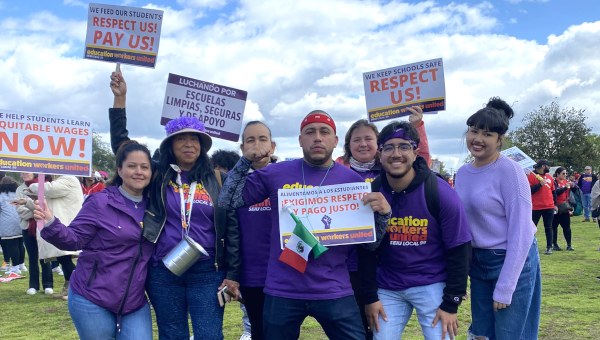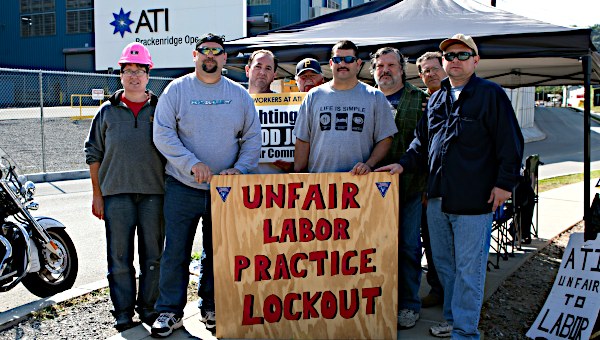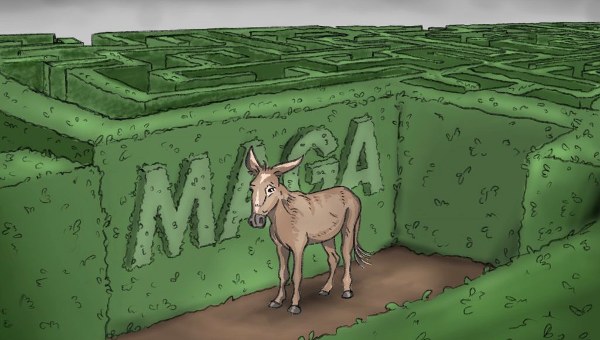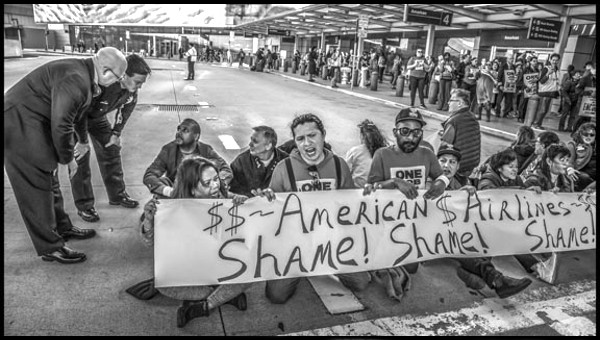Teachers’ Strikes: A New Class Politics Emerging
In the spring of 2018, teachers and school staff across the United States fought back and won. By walking out for better pay and school funding, hundreds of thousands of educators etched their imprint onto the course of history. The strike wave sparked by West Virginia produced a range of major victories. It also produced some great stories. While interviewing school employees during and after the walkouts, I’d always make sure to ask about their favorite moment of the struggle so far.
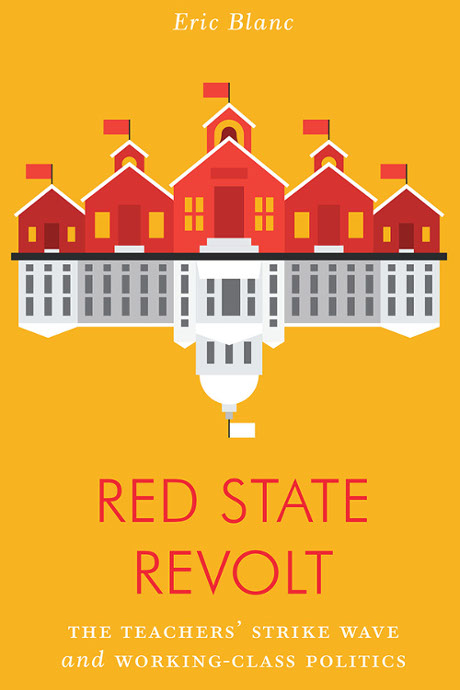 Some recounted the exhilaration of personally confronting a conservative politician. Many emphasized how proud they were of having become an organizer. Others told me about the joy of their first day back at school, when students thanked and high-fived them for taking a stand. More than a few were just relieved that they could now pay the rent.
Some recounted the exhilaration of personally confronting a conservative politician. Many emphasized how proud they were of having become an organizer. Others told me about the joy of their first day back at school, when students thanked and high-fived them for taking a stand. More than a few were just relieved that they could now pay the rent.
I was particularly moved by stories about small acts of support from strangers. Abby Broome, a teacher in Putnam County, West Virginia, wrote to me about one such experience. Her letter poignantly describes how the strike imbued routine interactions with a spirit of solidarity:
“I was walking to my car probably 4 or 5 blocks from the state capitol. I was alone, have to admit kind of insecure as I’m a young woman and I was alone in unfamiliar territory and it was getting late. I was wearing my strike sign around my neck, had on my red bandana and red strike shirt. I passed a bus stop where a couple people were waiting for the shelter. Under different circumstances, I don’t think any of us would have acknowledged each other. (We should have.) But this time one of the men spoke and said, ‘I support you. It’s awesome what you all are doing. Keep fighting.’
“Honestly, I was shocked. For weeks we had been ridiculed by some of our elected officials, the media, our own governor. But I learned that night that we had the support of hardworking people who know the struggle, working people probably having to take the city bus to work, people who fight every day to make ends meet, people who truly cared about what we were doing. It really changed things for me. I was tired like everyone else. I wanted things to get back to normal. But I felt energized and respected like I never had. I was proud. We were doing something bigger than ourselves. I think we were giving other people a little hope.”
Giving Hope
West Virginia’s walkout gave hope to working-class people well past state lines. Inspired by the Mountain State strikers, school employees in Oklahoma, Arizona, and beyond followed suit. Confounding all expectations, these actions erupted in Republican-dominated regions (‘red states’) with relatively weak labor unions, bans on public sector strikes, and electorates that voted for Donald Trump in 2016. And considering the fall 2018 work stoppages in Washington and a looming strike in Los Angeles, there is no sign that this militant educator upsurge will be short lived – nor confined to so-called red states.
This is a book [Red State Revolt] about the power of strikes. It tells the story of the thousands of educators like Abby Broome who took workplace action for the first time and were profoundly transformed in the process. It’s also a behind-the-scenes account of how militant teacher-organizers – most of them young radicals inspired by the 2016 Bernie Sanders presidential campaign – initiated these illegal rank-and-file rebellions and guided them to victory in alliance with their trade unions.
Finally, this book is an attempt to extract the main political lessons of the 2018 upsurge, the first wave of U.S. work stoppages in multiple generations. Our side doesn’t win very often; for decades, workers, organized labor, and the Left have been losing a one-sided class war waged by billionaires and their apologists. If we want to build an effective alternative to Trump and the Far Right, we can’t afford to ignore the experience of the red state revolt.
A Historic Upsurge
At most times and in most places, the norm is working-class resignation, rather than resistance. But the first few months of 2018 were one of those rare instances in U.S. history when ordinary people forced their way into the political arena, seeking to take their destinies into their own hands. In so doing, they transformed themselves just as much as they shaped their workplaces and society.
To quote Oklahoma teacher Gabrielle Price, educators “took a crash course in politics and government and will never be able to unsee what they have seen.” There is more than a little poetic justice in the fact that many strikers belonged to the “white working class” that liberal elites blamed for Trump’s election.
Teacher after teacher recounted to me epiphanies produced in the heat of struggle, ranging from disillusionment in Republican politicians to a newfound sense of individual and collective power. In the words of one Arizona educator: “Rallying at the capitol was one of few moments in my lifetime where I felt I stood exactly where one ought to – it was unequivocally purposeful, courageous and joyful.”
Teachers and support staff were not the only ones to reach new political conclusions. Millions of workers in each of these states witnessed a major social battle in which workers, for once, came out on top. A whole generation of young people, in particular, just learned firsthand that mass action is both legitimate and effective. To quote Oklahoma high school student Ravi Patel, “Our teachers are setting an example of bravery by standing up to ignorance and inaction … Our teachers are setting a better example than our legislators have for the past decade.”
Stepping Up and Rocking the Boat
To make these strikes a success, rank-and-file educators were obliged to step up in dozens of ways. Though labor unions played an important role in the walkouts, movement activities were often improvised from below, with all the strengths and limitations that this entailed. Their contributions included unglamorous tasks like making signs, collecting food for students, reading up on legislation, speaking with confused parents, texting a coworker to remind them to participate in the strike vote, or driving a group of peers to the capitol. Other actions required a bigger leap; for many teachers, this was the first time they’d made a speech at a rally, convinced coworkers to participate in a political action, spoken to the press, chaired a mass meeting, or confronted a politician.
In the span of a few months, tens of thousands of educators confronted and overcame personal fears, physical exhaustion, Republican bullying, and employer disciplinary intimidation. Initially, most doubted that a work stoppage was possible, because public sector strikes are prohibited in each of these states. As teacher Rebecca Garelli recalls, “People in Arizona were scared to rock the boat – and then West Virginia happened. All of a sudden, the catalyst was there. ‘They’re doing it, why can’t we?’”
Though breaking the law was not a decision easily undertaken, teachers eventually embraced their defiance. Highlighting the long tradition of taking illegal action to win a righteous cause, many strikers made homemade signs that read, “Rosa Parks was not wrong.” One West Virginia teacher posted the following to Facebook: “The way I look at it, Rosa Parks and Martin Luther King Jr. took a stand, I’d be in great company [if the state tries to throw us in jail].”
Legal threats were not the only ordeals they faced. In West Virginia, educators rallied for hours in the frigid rain; in Arizona, they marched and demonstrated in ninety-five-degree heat. Many also stressed the emotional turmoil associated with their participation in such a political rollercoaster. According to Azareen Mullins: “Our feelings were extreme from one minute to the next because of things that were happening inside the capitol doors. You’d feel exhilarated next to your chanting coworkers, but the very next moment you’d be crushed because of disappointing news from the Legislature. And then it’d start all over again.”
Specter of Labor Unrest
The Supreme Court’s anti-union Janus decision in June 2018 – throwing all public employees back into the open shop era – has given the red state revolt an added degree of momentousness. Pundits across the political spectrum announced that Janus would be the nail in organized labor’s coffin. But the walkouts clearly showed the potential for the revitalization of trade unions, even in the face of “right to work” laws and legal bans on strikes.
In fact, if the walkouts in Arizona, Oklahoma, and West Virginia are any indication, this Republican offensive may prove to be counterproductive for the ruling rich: by destroying the last remnants of public sector union security, the Supreme Court decision may thereby make militant workplace actions more likely. As a union lawyer for the American Federation of State, County, and Municipal Employees (AFSCME) warned the court on February 26, Janus risked raising “an untold specter of labor unrest throughout the country.”
Though not all of their demands were met, striking educators in West Virginia, Oklahoma, and Arizona achieved more in the span of two months than had been won over the previous two decades. That they wrested these concessions from intransigent Republican administrations – who for years prior stubbornly insisted that there was no money available to meet the teachers’ demands – made their achievements all the more significant. Both Oklahoma and Arizona, moreover, require legislative supermajorities to pass new taxes. Mass strikes have a remarkable knack for helping employers cough up concessions.
In West Virginia, the push for a work stoppage forced the state to freeze healthcare costs, cancel the imposition of invasive mandatory medical trackers, and drop both pro-charter school and anti-union legislation. Then, after almost two weeks of shuttered schools, West Virginia’s legislature caved to the strikers and granted a 5 per cent raise to all public employees – not only teachers. When I spoke with teacher leader Jay O’Neal in Charleston a few hours after victory was announced, he was ecstatic: “I’m thrilled, I feel like my life won’t ever be the same again. It sounds like hyperbole, but it’s not.”
The gains won in Arizona were also impressive. Through two months of mobilization and six school days of strikes, the ‘Red for Ed’ movement put sufficient pressure on the legislature to stop new proposed tax cuts, keep an anti-voucher referendum on the 2018 ballot, and win hundreds of millions of dollars in additional school funding. Teachers, moreover, obliged the state to grant them an immediate raise of roughly 10 per cent, with the promise of another similar increase a few years down the line. No less importantly, Arizona’s strike reversed Governor Doug Ducey’s attempt to tie any funding increase to cuts from Medicaid, the arts, and students with disabilities.
The achievements of the red state walkouts were not limited to the formal policy arena. Even more important than gains in pay and funding were the advances toward revitalizing the trade unions and rebuilding a militant workers’ movement. The illegal strikes in West Virginia and Arizona reflected, and spurred, a dramatic increase in working-class consciousness and organization, setting the stage for the conquest of further victories in the months and years ahead. To quote Garelli: “The movement and the walkout really increased people’s political awareness and our level of grassroots organization. Fifty per cent of the win here has been that we now have a strong, organized mass movement. And we’re not going away. People now have the courage to fight.”
In a marked reversal of fortunes for West Virginian organized labor, over 2,000 educators joined the unions in early 2018. Arizona – in which the union represented only 25 per cent of school employees before the strike – experienced an even deeper sea change. Roughly 2,500 new members have joined. On a Facebook thread concerning the lessons of the strike, a teacher explained: “The word ‘union’ does not scare me anymore. I joined [the Arizona Education Association] and plan on continuing to fight for what is right for educators and students. I feel the most empowered I have ever felt as an educator and now do believe that change is possible.”
Reversal of Trends?
This revolt shares important similarities with the last great round of rank-and-file radicalism in the United States, the strike wave of the late 1960s and early 1970s. But there are some critical differences. Whereas labor struggles four decades ago came in the wake of a postwar economic boom and the inspiring successes of the civil rights movement, this labor upheaval has erupted in a period of virtually uninterrupted working-class defeats and neoliberal austerity. As such, political scientist Corey Robin was right to call 2018’s educator upsurge the “most profound and deepest attack on the basic assumptions of the contemporary governing order.”1
The stakes are high. Public education remains one of the few remaining democratically distributed public goods in the United States. For that very reason, corporate politicians have done everything they can to dismantle and privatize the school system. As political economist Gordon Lafer documents in his book The One Percent Solution, this isn’t only about immediate profits. Big corporations, he writes, are trying “to avoid a populist backlash” against neoliberalism “by lowering everybody’s expectations of what we have a right to demand as citizens”:
“When you think about what Americans think we have a right to, just by living here, it’s really pretty little. Most people don’t think you have a right to healthcare or a house. You don’t necessarily have a right to food and water. But people think you have a right to have your kids get a decent education.”2
Struggles to defend public education, in other words, have political implications that reach far beyond the schools themselves. Each of the teacher strikes raised the question of whether the tremendous resources of the richest country on earth should be used for meeting human needs or for deepening corporate profits. In a context marked by deepening social crisis and widespread popular anger, we should not underestimate the urgency of this issue. To counter the racist fearmongering of Trump and his supporters, moral condemnations are not enough. A credible political alternative must be provided.
Since West Virginia’s strike erupted in February 2018, it’s become clear that a new labor movement is not only necessary, but possible. To quote Arizonan music teacher and Red for Ed organizer Noah Karvelis: “The types of attacks we’ve seen in Arizona are common to the working class across the whole country. If educators in Arizona could stand up and fight back, anybody can stand up and do the same.”
To the surprise of all, this frontal challenge to austerity and neoliberalism came in the form of illegal statewide strikes in Republican “right to work” bastions. Since unions in these states were relatively weak and collective bargaining virtually nonexistent, the strikes took on an unusually volcanic and unruly form. In an unprecedented historical development, much of the organizing for these actions took place in secret Facebook groups where teachers could share their fears, hopes, personal stories, and action proposals (as well as countless silly memes). And with union officials reluctant to call for illegal mass action, rank and filers stepped into the leadership vacuum and filled it to the best of their abilities.
Lessons Learned
One of the main lessons from the red state revolt is that the Left needs labor just as much as labor needs the Left. Fortunately, socialists and the labor movement are beginning to overcome their decades-long divorce. In an interview conducted over celebratory beers, an hour after West Virginia strikers won their demands, Emily Comer – a socialist teacher, union member, and strike leader in Charleston – put it well: “If you have enough working people who are pushed to the breaking point, and who are angry about a specific grievance, then it’s the duty of activists to let them know that they deserve better – and that their lives can get better if they take action on that issue. If you lead the way, people will respond.”
This book describes the development of the strike wave through the words and perspectives not only of its rank-and-file participants, but also those of its main grassroots organizers. For both diplomatic and tactical reasons, activists in 2018 were reticent to publically speak about the internal conflicts that drove these movements forward. As such, the full story of their development has not yet been made public.
To understand how I was able to get this insider’s take, some background information might be helpful. Last spring, Jacobin magazine sent me to be its on-the-ground correspondent for the strikes in West Virginia, Oklahoma, and Arizona. Truth be told, my journalistic credentials at that point were nonexistent. My parents are both union activists, and I was a high school teacher – and leftist public education organizer – in the Bay Area until 2017. Like so many of my colleagues, my meager teacher wages pushed me to go back to school; the strike wave popped off during my second semester as a doctoral student in sociology at New York University.
Upon arriving in each of the strike states, I’d immediately explain my personal-political background to the local organizers. I told them the truth, which was something to the effect of: “I’ve got to write some articles about what’s going on, but, mostly, I want you all to win – so, please, put to me work if you can.” Ultimately, I spent the bulk of my time organizing national solidarity for the strikers and talking politics with the core teacher activists over nightly beers.
The upshot was that, although I missed more than a few article deadlines for Jacobin, I ended up earning the trust of key rank-and-file leaders. They gave me access to their internal meetings, their secret Facebook groups, and even many of their personal texts. Without that inside information, there’s no way this book would have been possible.
To supplement these personal observations and the abundant primary sources embodied in the Facebook groups, I scoured the local press and also interviewed over one hundred teachers, service personnel, organizers, students, union staffers and top officials, and superintendents. Politically, these individuals ranged from Trump supporters, to liberal trade unionists, to socialist cadre – and I suspect that each will agree and disagree with aspects of my analysis. Though this is an unabashedly partisan account, I’ve tried hard to remain scrupulously committed to the facts, fair to those I criticize, and critical of those I support.
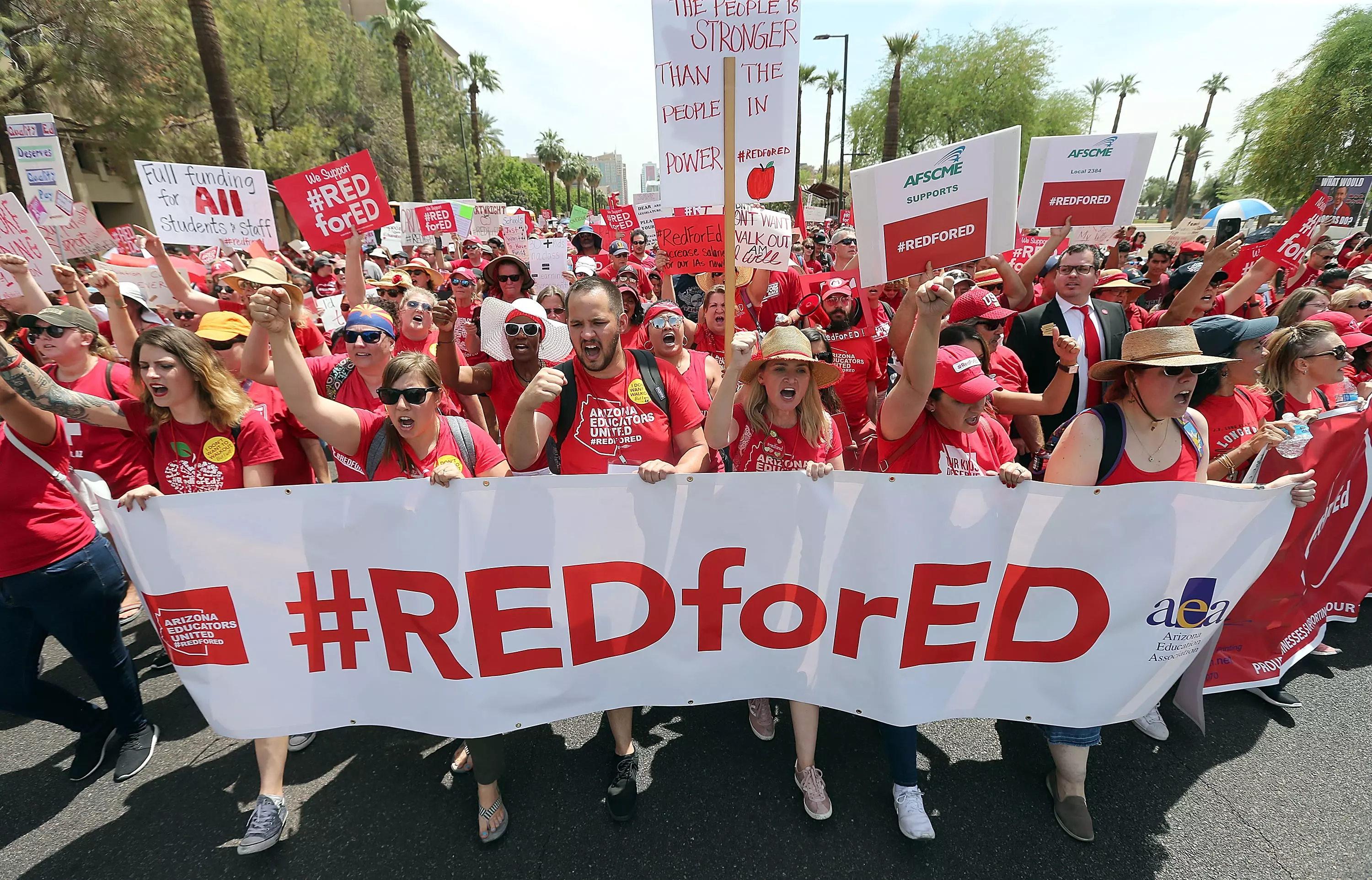
And one final note on geography: this book deals with the West Virginia, Oklahoma, and Arizona strikes, which were by far the most important actions of the spring 2018 red state movement. The strikes in these three states were multiday work stoppages, unlike the one-day, mostly symbolic walkouts that took place in Kentucky, North Carolina, and Colorado. Likewise, I don’t delve into the recent work stoppages in Washington and other blue states – these actions, developing as they did in Democratic-run regions where strikes are not illegal, merit their own separate study.
It’s a welcome complication that by the time this book hits the shelves, there could very well be new educator struggles erupting in unexpected places throughout the United States. In the same way that teachers in West Virginia and Arizona learned from the successes of Chicago’s 2012 school strike, the 2018 experience should be of considerable use to public education workers and their allies in these battles to come.
From Trump’s vicious scapegoating to the looming threat of climate catastrophe, rays of political hope are few and far between. At this dangerous and volatile juncture in U.S. history, it’s easy to fall into despair. But the 2018 education strikes not only underscore the immense potential for mass working-class politics; they also provide important insights into how this latent power can be tapped.
Working people are angry and looking for alternatives to business as usual. In the least likely of circumstances, school employees in West Virginia, Oklahoma, and Arizona rose up and dealt a serious blow to the forces of reaction. For everyone across the country who is eager to do the same, there’s no better place to start than by learning about the red state revolt. •
This article is an excerpt from the book Red State Revolt: The Teachers’ Strike Wave and Working-Class Politics, Verso (2019).
Check out this Oats for Breakfast podcast with Eric Blanc.
Endnotes
- Corey Robin, “Striking Teachers Are ‘Real Resistance’ to ‘Incoherent’ Republicans and ‘Gutted’ Dems,” interview by Amy Goodman, Democracy Now!, April 12, 2018.
- Cited in Lynn Parramore, “The Corporate Plan to Groom U.S. Kids for Servitude by Wiping Out Public Schools,” Institute for New Economic Thinking, April 6, 2018.


